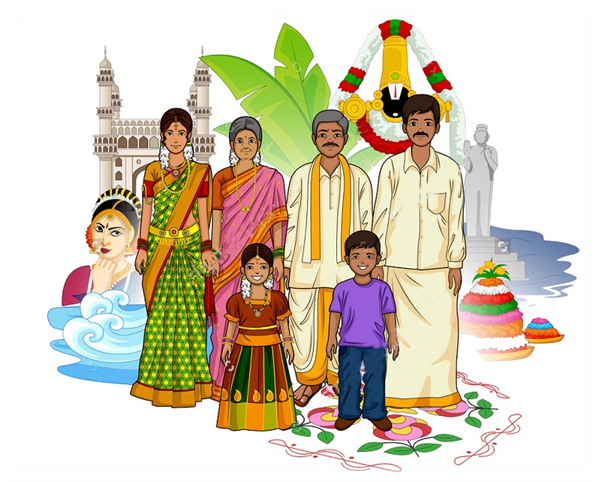Andhra Pradesh is one of the 29 states of India, situated on the south eastern coast of the country. The state is the 8th largest state in India; the state is the 10th largest by population, has one of the longest coast lines running along the Bay of Bengal, is the powerhouse of immense deposits of minerals and is very rich in agriculture and textiles. Innovations in the textile and jewelry making industry enhanced the state’s repertoire of fashion and jewelry designs. The state is home to the fashion and traditions of the finest cloth making and dyeing techniques. All types of cotton fabrics come in a wide range of counts from light weights to heavy coarse fabrics. These diverse ranges have had a tremendous effect on Andhra Pradesh culture and tradition. This spectacular variety has made Andhra Pradesh incredibly rich in culture and heritage.

https://www.indianeagle.com/traveldiary/andhra-pradesh-culture-and-tradition/
TEXTILES OF ANDHRA PRADESH
Andhra Pradesh is well-known for its huge variety of traditional silk and cotton saris. Many districts in Andhra Pradesh have their own unique weaving patterns, styles and methods. Saris that are specific to a particular district are named after their places of origin. Apart from the designs, the fabric that is been used in making the sari is different from one district to another, it has its own specialty and uniqueness. Here are the textiles of Andhra Pradesh.
Venkatgiri Sari:-

https://www.weavesmart.com/collections/venkatagiri-sarees
The Venkatgiri Saris, known for their fine weaving, date back to early 1700 when these sarees were produced at an artisan cluster close to Nellore called Venkatgiri. The place was then known as ‘Kali Mili’ and its famous product was patronized by the Velugoti Dynasty of Nellore.
- Place: – Venkatgiri.
- Fibre: – Woven with fine cotton yarn and zari.
- Style: – They are popular for their unique sari designs. These saris are in the form of stripes in the border and pallu.
- Loom: – Fine weaving. The looms used are mostly pit looms. The looms which are fixed at the ground level and there is apit in which the loom’s pedal is placed. The weaver will sit on the floor and use his/her hands and legs to weave.
Uppada:-

https://www.weavesmart.com/collections/venkatagiri-sarees
Also known as Uppada Pattu, Uppada Silk Saris. Uppada silk sarees are defined by the length and breadth count of threads.
- Origin and History: To understand the history of Uppada silk, one has to first trace the journey of the Jamdani weaving techniques. After a decline in the 19th century due to the industrial revolution in England. Jamdani saw a slow resurgence in the 20th century. Thereafter the technique of Jamdani was introduced in Uppada in the year 1988 where it incorporated designs which were closely identified with Andhra Pradesh. This led to the birth of a new design range called the Uppada silk sari. However it still took about 10years for the Uppada silk sarees to get the due recognition and popularity.
- Place: Uppada silk is named after a small beach town of Uppada in East Godavari of Andhra Pradesh.
- Fibre: Cotton warp.
- Technique :
- Design is made from the age old Jamdani method. Using only non-mechanical techniques. The artisans also use a lot of zari work in the exquisite designs of Uppada silk sarees.
- The length count of threads is 100 and the breadth count is 100 in the weaving process of Uppada silk sarees.
- Jamdani made in Uppada has two weavers working on a single loom and weaving delicate and beautiful designs on the fabrics by zari work.
- Recreating a Jamdani weaving process was extremely difficult in the initial phase, because to familiarize the weavers with intricate skills of hand weaving took a lot of time.
- The saris are light weight and almost translucent.
- Uppada silk sarees are among the more expensive varieties of silk sarees in the world.
Mangalgiri Sari:-
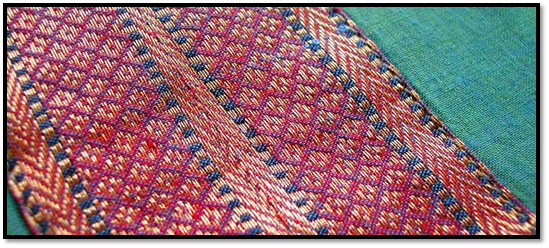
https://loomtree.com/pages/from-andhra-praddesh
Mangalgiri is famous for its two well-known temples and handloom sarees.
- Place : Mangalgiri is located 12kms away from Vijaywada.
- Fibre : Cotton along with zari (now silk also)
- Design: Strips in pallu and checks are the chief identification. Now intricate tribal designs are woven in or golden coloured patterns that occur in small checks.
- Colours: Bold colour that looks translucent.
Kalamkari:-
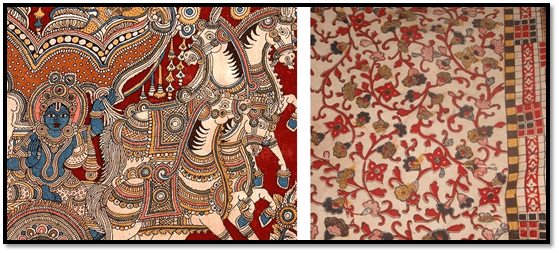
https://loomtree.com/pages/from-andhra-praddesh
Kalamkari is an ancient style of hand painting done on cotton or silk fabric with a tamarind pen, using natural dyes. The word Kalamkari is derived from a Persian word where ‘kalam ‘means pen and ‘Kari‘ refers to craftsmanship. Motifs drawn in Kalamkari spans from flowers, peacock, and paisleys to divine characters of Hindu epics like Mahabharata and Ramayana.
- Place: Masulipatanam.
- Fibre: Cotton locally called as Gaada, sometimes silk now a days.
- Technique: Cow dung mixed in cow milk in a mud pot is kept overnight for softness natural background colour. It is then squeezed loosely and kept it on the floor overnight. Next day early morning these pieces are washed, after that the pieces are spread on grass and water is sprayed on the cloth with some interval till 12:30.
- Mordanting process: Myrobalam seeds are powdered and soaked in water for one day. Next day, it is filtered with gunny cloth. The ready cloth pieces are dipped one by one in the juice extracted, squeezed properly and then dried in sun or alum holds the colour and second side holds the fabric to save from getting stretched.
COSTUMES OF ANDHRA PRADESH
The traditional wear of Andhra Pradesh is not much different from other southern states of the country.
Men:-The men in Andhra Pradesh generally wear dhoti and kurta.

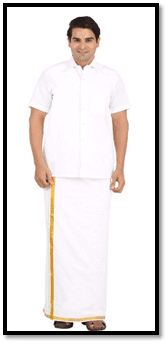
Dhoti:-A dhoti or dhotee´ is a large piece of cloth that is wrapped around the waist and is tucked from between the legs. The length of the dhoti worn is according to one’s preference. The dhoti can be either till knee length or ankle length.
Kurta:-Kurta is the top worn by the men in Andhra Pradesh. They are usually made up of cotton. The length of the sleeve is wrist (full) length, three-fourth or half.
Shirt:-Even though Kurta is traditional wear, men have also started wearing shirts and T-shirts and shirts instead of Kurta.
Lungi:-Men in Andhra Pradesh also were lungis. Lungis are a piece of clothing simply wrapped around the waist. Muslim men wear pajamas in place of dhoti and kurta with a Fez Cap (cylindrical red cap).
Women:-Before the 14th century, women in Andhra Pradesh wore dhotis, just like the men did. But over the years, the length of their dhoti kept on increasing and much later, they started using an additional piece of cloth to wrap over their shoulders. The additional piece of cloth later got stitch together to form a sari.
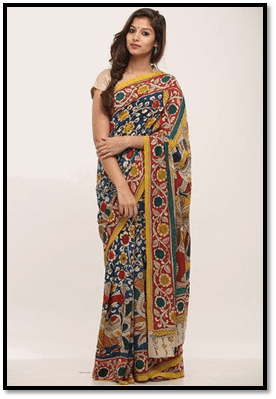
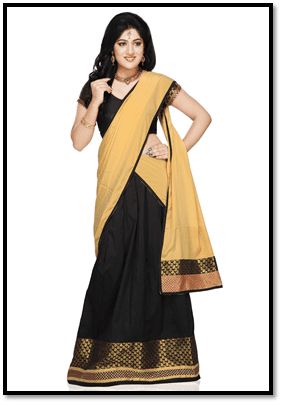
Sari:-The sari is a long length of cloth (usually 5½ meters or 6 yards long) that is wrapped around a woman’s lower body, and the excess is draped across their torso, over the blouse.
Women wear blouses to cover their upper body. The blouse comes till mid-torso. They may be stitched however the wearer desires it to be – with different types of colour work, lengths of the sleeve and even length of the blouse may alter.
Langa Voni:-Langa Voni is a two-piece or a half sari worn by girls or young women in south India. It consists of a skirt, blouse and a dupatta. Girls wear Langa Voni before they get married or before they hit puberty. They may also wear it without a dupatta.
Petticoat:-Women wear a petticoat or an underskirt below their sari.
Andhra Pradesh is well known for its quality handloom industry. Women prefer to wear these original handloom sarees. Dharmavaram, Kanchi, Chirala, Mangalgiri, Venkatagiri towns have a worldwide reputation for their production of hand looms. Dharmavaram is famous for the production and distribution of silk sarees. Ikkat sarees woven in the Nalgonda district needs a weaving-pattern in which the yarn is randomly dyed in geometric or zigzag manners. Mangalgiri sarees are made of fine cotton. Gadwal sarees are also well known.
TRIBAL COSTUMES OF ANDHRA PRADESH
Lambadies:-

Lambadies or the Banjaras are a common tribal group in Andhra Pradesh. The men of the tribe have adapted to wearing the dhoti-kurta, but the women continue to wear their traditional dress. The traditional dress for the Lambadi women comprises of a long – ankle-length skirt, a blouse and a ghoonghat or dupatta (an additional piece of cloth). Their clothes are very colourful, vibrant and heavy. The dupattas and skirts have thick borders, and the entire costume has a mirror, bead and stonework on it. They also wear bangles, anklets and other jewellery. Women of all communities wear sari and blouse. Some Muslim women also wear salwar kameez.
EMBROIDERY OF ANDHRA PRADESH
Banjara Embroidery:-

Banjara Needle work form belongs to the nomads and gypsies of Andhra Pradesh. The embroidery of this form is live and vibrant. Banjaras in Andhra Pradesh display their colourful lifestyle through their exuberant clothes.
Banjara Needle work is a local tribal craft practiced by the ‘Banjaras’ (tribal) of Telangana Region. It differs from the embroidery of Gujarati and Kutch Banjara. It has a style of its own, the originality and brightness are accentuated by its matchless quality. Needlework is an integral part of this craft and patterns are basic geometric combinations, squares, triangles and diamonds.
The Banjaras produce exuberant embroideries using colourful threads. All they need is a piece of cloth and a needle and their imagination gets going. Intricate stitches in vibrant colors and the use of beads, shells and mirrors conjure a magic created by nimble fingers, glass beads and mirror. The Banjara women of Andhra Pradesh bedeck themselves with gaghras, cholis and odhnis which are ornamented in bold appliqué and mirror work.
Typical items include cushion covers, bags, skirts, ‘kurtas’, dress sets for girls and women, blouse pieces, bedspreads and other household furnishings.
The Crafts Council of Andhra Pradesh with its sustained market promotion is revitalising the art by improving the quality and standard of work by assisting them in procuring better raw material.
Raw Materials used:-
The fabric is worked upon with a long needle, threads, tikris and beads. Multi sized frames are used, usually about 1.5 feet high, to secure the cloth on which the design is sketched with a stencil. One hand secures the thread under the cloth to the needle while the other hand moves the needle on top of the cloth with ease.
Process:-
As embroidery is not so technical craft to follow procedure but then also small process like:
- The motif is made on the tracing screen for symmetrical marking and uniformity, like the Khaka.
- The motifs are marked on the fabric with a marking mixer (liquid) for embroidery work.
- Now set the marked fabric very tight from all directions. (Sari, Dress materials, etc.)On Wooden frame (it can be done without frame also).
- It will work easier to do embroidery with the help of frame to reduce tension and get pucker less product.
- The desired motif is neatly embroidered with different stitches (Pakko, Kachho, Soof, Rabari, kharek etc.) to achieve desired motif.
- The result can be many colours and is easy to make.
Set the fabric (Sari, Dress, material, etc.)
on Wooden frame(it can be done without frame also) according to the design with
desired allowance for the product. The motif is made the tracing screen for
symmetrical making and uniformity, like the Khaki. The motif is marked with a
marking mixer in a liquid form (Kerosene and gala powder) whether for
embroidery the desired motif is neatly embroidery with different stitches to
achieve desired motif.
Embroidery designs are prepared by fixing small round shaped mirrors to the
material with the help of the buttonhole stitch, the outline being sketched by hand.
Silken thread is used for the stitching done in stem or herringbone, closely worked.
Flowers and creepers are patterned against a dark background.
Techniques:–
Techniques vary with the community and region. The term embroidery is basically defined as the method of ornamenting a piece of clothing with needlework; or embellishment with fanciful details. Thus embroidery is regarded as the art of decorating textiles using a needle and thread. This includes the hand and machine embroidery methods. And till date, hand embroidery continues to be an expensive and time-consuming method. However, in spite of this it is preferred because of the intricacy of the handiwork involved.
The basic techniques an embroiderer uses includes:–
- Cross stitch
- Crewel work
- Quilting
- Chain Stitch
- Stem Stitch
- Couching Stitch
- Applique Stitch
- Mirrors Stitch
- Kasida Stitch
Bead Embroidery:-

The rich cultural heritage of the state of Andhra Pradesh is noted for coming up with innovative ideas to make the craft here more vibrant and creative. Bead Embroidery is used on the fabrics to beautify them with the help of bright and colourful beads. The main idea behind the bead embroidery is to make the mundane and common fabric look fancy and unique.
CRAFT AND CULTURE
Kondapalli:-

The Kondapalli dolls of Andhra Pradesh are light weighted wooden dolls, which come from a small village called Kondapalli in the vicinity of Vijayawada. The dolls are so adorable yet warm and realistic. The faces of the figures are extremely expressive and the subjects are taken from our life. Soft Poniki wood is used to create these dolls and toys, which depicts everyday scenes, figures of deities, animals, birds and mythological characters.
Decorative hand crocheted lace:-
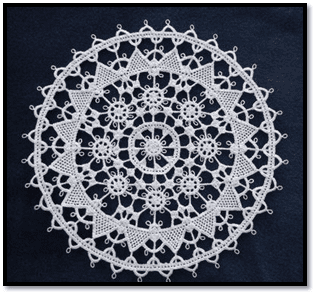
The Decorative hand-crocheted lace work of Andhra Pradesh is a kind of handicraft, which is one of the most contemporary handicrafts of the state. This type of decorative art is prominent in the Narsapur and Palakollu of West Godavari district. The Decorative hand-crocheted lace work is widely used to design dining mats. It is also used to beautify bed sheets, pillow covers, telephone covers, wall hangings, tea cosy, dressing table mats and curtains.
Butta Bommalu:-

Butta Bommalu is a popular dance form in the state of Andhra Pradesh. It is the foster child of the West and East Godavari districts of Andhra Pradesh. The name Butta Bommalu literally means puppets made in the form of basket. Butta Bommalu or the basket puppets are made out of thin bamboo strips. These strips are woven into the shape of long spherical basket figures.
Bidri:-

The complicated and the very beautiful Bidriware was developed during the gothic times. Bidriware was originated in the 14th century C.E., during the reign of the Bahamani Sultans. The term ‘Bidriware’ arises from the township of Bidar, which is still the head centre for the manufacture of the antique metal work. Bidriware is an important export handicraft of India and is seen as a symbol of wealth because of its striking inlay artwork. BIDRI is a specialized metal handcraft manufactured in Andhra Pradesh. The basic material used in order to make this craft is an alloy of 6% copper and 94% zinc.
Nirmal Paintings:-

Adding to the list of the envious collection of fascinating art and craft forms, the Nirmal Paintings of Andhra Pradesh holds a significant position in the art and handicraft sector of the state. The exquisite traditional art form of Nirmal Paintings has earned its name from the Nirmal town in Adilabad district, where it is mostly seen.
OFFICIAL TOURISM GOVERNMENT WEBSITE

Andhra Pradesh Tourism Development Corporation (APTDC) is a state government agency which promotes tourism in Andhra Pradesh, India.
And the official web site is – www.aptourism.gov.in
- REFERENCE
https://loomtree.com/pages/from-andhra-praddesh
https://www.holidify.com/pages/andhra-pradesh-dresses-123.html
https://www.onlytravelguide.com/andhra-pradesh/arts-crafts/banjara-needle-crafts.php
https://www.craftclustersofindia.in/site/index.aspx?Clid=654


